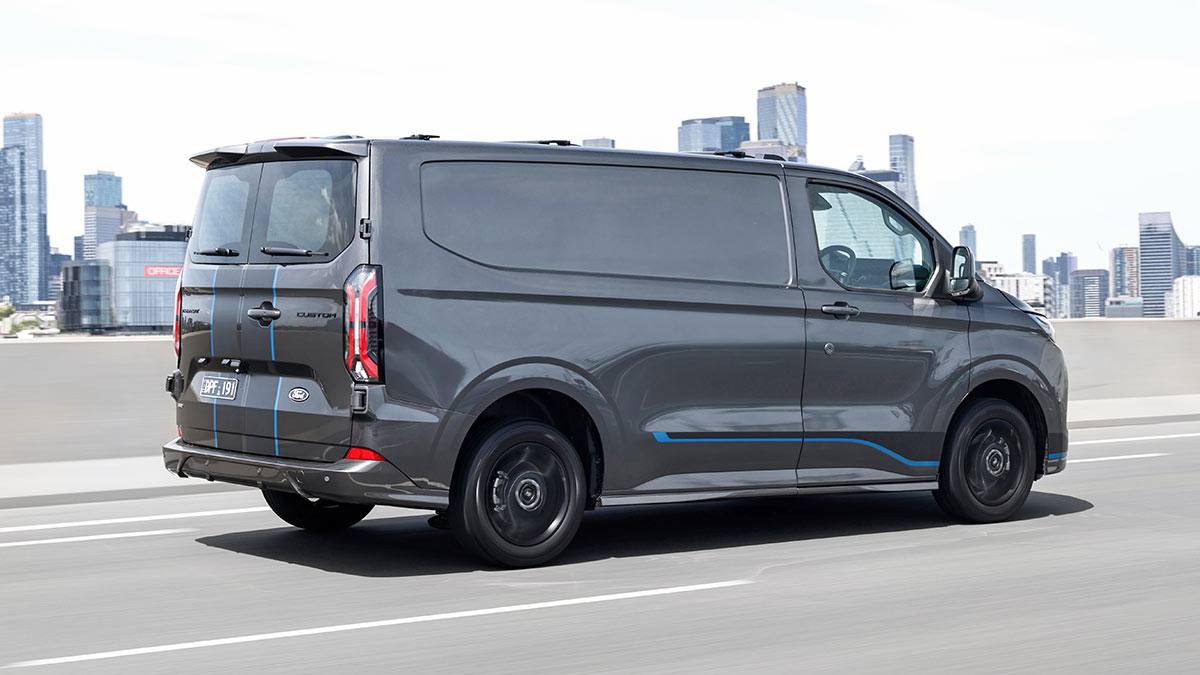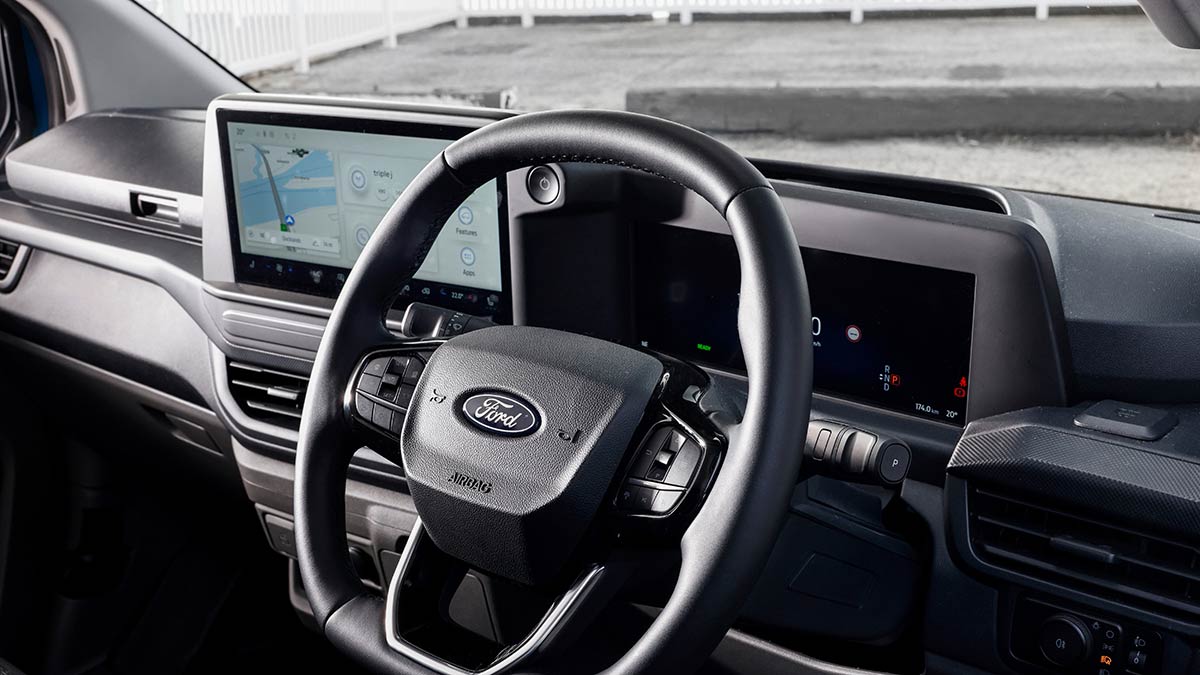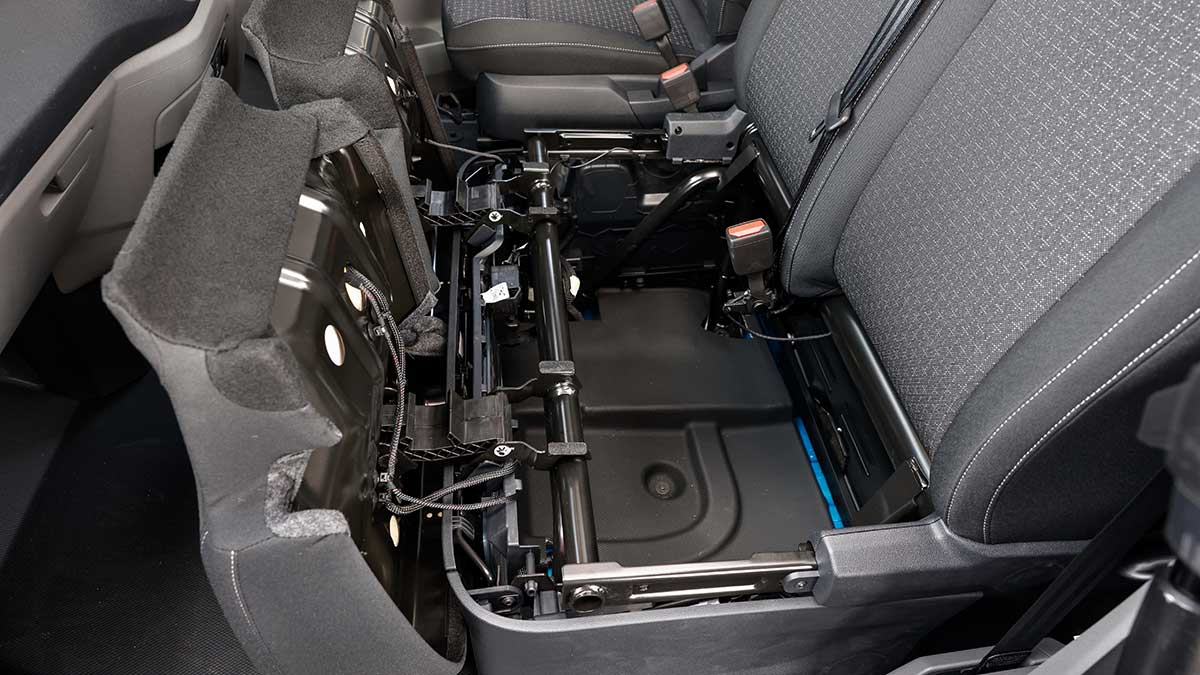The new plug-in hybrid electric BYD Shark 6 has shaken up the dual-cab ute segment, but how does it rate against the PHEV version of the top-selling Ford Ranger?
2025 Ford Transit Custom Trail, E-Transit and PHEV review

The Ford Transit Custom van is breaking new ground with the AWD diesel Trail, full-electric E-Transit Custom and first-in-class PHEV plug-in hybrid, but are Australian buyers ready to change?
Ford is recasting the traditional white trade van as a more versatile option for a broad range of Australians with three new variants of the 2025 Ford Transit Custom – the rugged four-wheel-drive diesel Trail, the battery-electric E-Transit Custom and petrol-electric Custom PHEV.
The aim is to bring some of Europe’s prevalent van culture to ute-loving Australia, taking lessons from its best-selling Ford Ranger ute line-up with models that appeal to private owners as well as commercial business operators, and which combine work duties with recreational pursuits.
Ford of Europe’s commercial vehicles product development director, Ian Foston, who was also global chief engineer for the Aussie-developed T6 Ranger and Everest, told RACV: “We’re going to try and serve customers all the way from the commercial end of the business, right up to the more recreational, premium, rugged end of the market as well – in a similar way we’ve done with Ranger.”
While the Ford Transit Custom Trail takes the Blue Oval’s medium-sized one-tonne van off-road for the first time, Foston said the Transit Custom EV and first-in-class PHEV options were likewise a direct response to customer demands for lower running costs and emissions.
“It’s not weaning us off diesel, it’s providing the customers what they want – and we are flexible,” he said. “We can offer them EV, plug-in hybrid or a diesel – it’s the choice of the customer. It’s also the choice of many governments in terms of what incentives they offer, how they legislate, where they’re going in the future. But from Ford’s point of view we’re really just reacting to what customers want.”
This might be true from an international perspective, but Australia will be a rough row to hoe given preferences for diesel power are deeply rooted in the light commercial sector – and vans aren’t the first choice for excursions off the beaten track.
Is it time to reconsider? We’ve taken a first drive in the 2025 Ford Transit Custom Trail, E-Transit Custom and Transit Custom PHEV to find out.
More: Research and compare vans and utes on sale today in Australia
In this review
- How much does the Ford Transit Custom Trail, E-Transit and PHEV cost?
- Ford Transit Custom Trail, E-Transit and PHEV exterior design
- Ford Transit Custom Trail, E-Transit and PHEV towing, payload and load space
- What is the Ford Transit Custom Trail, E-Transit and PHEV like inside?
- Is the Ford Transit Custom Trail, E-Transit and PHEV good to drive?
- Is the Ford Transit Custom Trail good off-road?
- What safety features does the Ford Transit Custom have?
- How does the Ford Transit Custom compare?
- Should I buy a Ford Transit Custom Trail, E-Transit or PHEV?

The 2025 Ford Transit Custom Trail is designed to reach off-road locations, not unlike a typical 4x4 ute.
How much does the Ford Transit Custom Trail, E-Transit and PHEV cost?
The unique proposition brought with the 2025 Ford Transit Custom Trail, E-Transit Custom and Custom PHEV brings premium pricing in each case – and significant upticks with the electrified twins.
For the all-wheel-drive Trail, which is based on a mid-spec trim level (similar to Trend) to help free up funds for owners to invest in customisation for their intended use, pricing starts from $61,990 plus on-road costs. This represents a $4400 list price increase over the comparable long-wheelbase Transit Custom Trend, which uses the same 125kW/390Nm 2.0-litre turbo-diesel engine and eight-speed automatic transmission, but drives the front wheels only.
The Ford E-Transit Custom BEV and Transit Custom PHEV are both available in Trend LWB and Sport SWB model grades. The E-Transit Custom uses a 160kW/415Nm single-motor/rear-drive powertrain and starts from $77,590 for the Trend LWB and from $79,990 for the Sport SWB (both plus on-road costs). That signifies a whopping $20,000 above equivalent diesel-powered Transit Custom variants.
You can cut this down to $10,000 for the Transit Custom PHEV, which produces a combined 171kW/400Nm from its 2.5-litre petrol engine/electric motor (driving the front wheels via a CVT transmission) and opens at $67,590 for the Trend LWB and $69,990 for the Sport SWB.
“It’s no secret that battery technology continues to be expensive and anything that we bring to market has to have a business case behind it,” said Ford Australia marketing director Ambrose Henderson. “In saying that, we wouldn’t bring something in which we weren’t confident we could sell and we weren’t confident that customers wanted.”
“I think the segment will grow over time and I think it’s a fair price for the technology that the vehicle brings. And for people in those particular use cases, they will pay that back in a much-less-than-average ownership cycle of a Transit,” he added.
No figures were forthcoming on how long it will take before the purchase price premium for the electrified models compared to diesel can be recouped via lower running costs. Ford executives said payback periods would hinge on individual circumstances such as location (metro/regional), usage patterns (including average kilometres travelled and towing requirements) and home EV charger installation (with support from solar panels and batteries).
With routine maintenance costs, Ford’s pre-paid capped-price servicing plans available through its 180-strong dealer network show the difference between EV, PHEV and diesel. Across the first five services – based on intervals of every 12 months or 30,000km (whichever comes first) for all models – the E-Transit Custom costs $200 on the first, third and fifth service and $300 on the second and fourth, totalling just $1200 across the term.
In comparison, the Transit Custom Trail and the PHEV both cost $499 for each of the first four services and vary only on the fifth year/150,000km mark, where the AWD diesel costs $535 compared to the hybrid at $475. Over the full period the total is $2471 (PHEV) and $2530 (Trail) – not much between them but double the price of the EV.
All Transit Custom models are covered by Ford Australia’s five-year/unlimited-kilometre factory warranty. The high-voltage batteries in the EV and PHEV are covered by a separate eight-year/160,000km warranty. Most, but not all, Ford dealers are equipped to handle EV servicing. The company says that by the end of 2025, there will be 150 dedicated EV dealers.
More: Car servicing costs and differences: EV vs Petrol vs Diesel
Ford Transit Custom Trail, E-Transit and PHEV exterior design
The 2025 Ford Transit Custom is a body-on-frame mid-size one-tonne van that in Custom Trail guise – which is based on the long-wheelbase variant – measures 5450mm long, 1999mm wide (without mirrors) and 1963-2031mm tall at kerb weight (range between unladen and fully laden). There is no extra ground clearance compared to regular LWB models and the wheelbase is 3500mm.
The Trail is immediately recognised by the bright yellow sticker pack with Trail badging and a thick sporting line that starts at the lower front bumper and runs down each side. It also has a unique grille and skid plates, black wheel-arch mouldings, chunky silver painted lower side trim, LED headlights (upgrading from halogen bulbs on other models), steel underbody protection and unique 16-inch double-arm matte-black alloy wheels with the option of all-terrain tyres.
The Ford Transit Custom EV and PHEV have comparable dimensions in Trend LWB form, while the Sport SWB is 5050mm long (-400mm) and rests on a 3100mm wheelbase (-400mm).
Apart from badging, the main identifying markers include an aero-optimised grille with a trapezoid design on E-Transit that directs airflow to powertrain components. The Sport SWB has 17-inch alloys (up from 16-inch steel rims with covers on Trend LWB), a body kit, rear spoiler and racing stripe stickers that run the length of the van. The battery charging port for the EV and PHEV is located in the front right bumper.
Frozen White exterior paint is standard, with prestige colours adding $700 – Agate Black, Moondust Silver, Grey Matter, Magnetic and Digital Aqua Blue. More than 50 SVO paint options are also offered on Trend models for $1400.
On all Transit Custom vans, a rear liftgate can replace the twin barn doors for another $700 while dual side doors add $1000 over the standard single kerbside sliding side door.
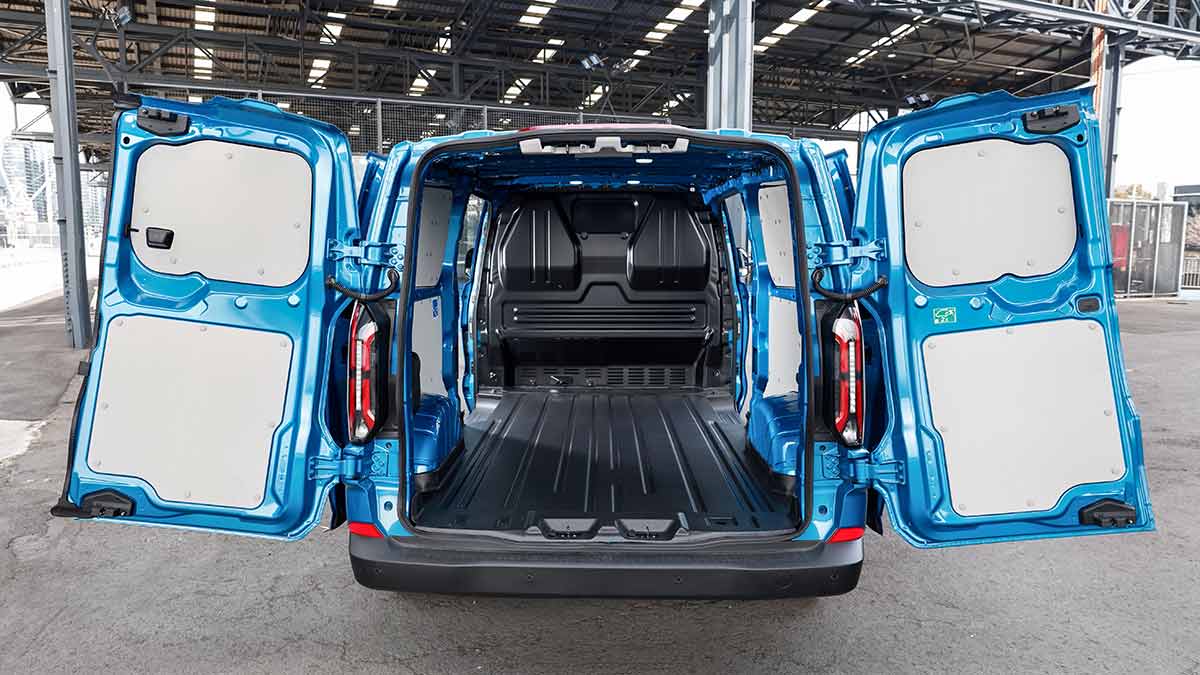
The 2025 Ford E-Transit Custom has the same load space as equivalent diesel models, but a slightly lower 2300kg towing capacity.
Ford Transit Custom Trail, E-Transit and PHEV towing, payload and load space
The AWD 2025 Ford Transit Custom Trail has a 2500kg maximum braked towing capacity, down 300kg compared to the front-wheel-drive Trend LWB. Payload is 1179kg based on the 2046kg kerb weight. Gross combined mass (GCM) is 5725kg, gross vehicle mass (GVM) 3225kg and the axle plated mass (front/rear) 1700/1850kg.
Based on the LWB Transit Custom, the Trail has a 6.0-cubic-metre load volume (VDA standard) with a bulkhead in place. The cargo box is 3002mm long up to the bulkhead (3450mm via a small load-through hatch), 1392mm wide between the wheel-arches and 1425mm high from floor to roof.
The battery-electric RWD Ford E-Transit Custom and FWD PHEV have a slightly lower 2300kg towing capacity for both the SWB Sport and LWB Trend. Payload for the EV is 1111/1187kg for the SWB/LWB, based on a 2114/2163kg kerb weight respectively. GCM is 5350kg, GVM 3225/3350kg (SWB/LWB) and axle plated mass 1400/1600kg at the front (SWB/LWB) and 2000kg at the rear for both variants.
There are some slight differences with the PHEV (SWB/LWB) figures – payload is higher at 1255/1206kg, kerb weight lower at 1970/2019kg, GCM 5225kg, GVM 3225kg and axle plated mass 1600/1700kg front and 1900/1750kg rear.
Importantly, the Transit Custom EV and PHEV have the same load space as the regular diesel SWB and LWB models – 5.2 and 6.0 cubic metres respectively. The LWB cargo dimensions are the same as those for the Trail, while the SWB load length is 2602mm to the bulkhead (3050mm with load-through hatch), width between wheel-arches is 1392mm and height 1427mm.
On all Transit Custom versions, the load area has LED lights, tie-down hooks, protective wall panels, a moulded floor covering and a metal bulkhead with the load-through hatch as standard. The E-Transit goes without an interior rear window cutout and instead features a digital rearview mirror with integrated dash-cam. This ‘secure visibility pack’ is also optional on the PHEV Trend ($1500) but isn’t available on the Trail at launch.
The Trail and PHEV models have a temporary space-saver spare wheel under the vehicle at the back end – the jack is mounted inside at the rear pillar – however the E-Transit does not have a spare, relying instead on an inferior puncture repair kit.
What is the Ford Transit Custom Trail, E-Transit and PHEV like inside?
All variants of the 2025 Ford Transit Custom have an appealing, comfortable and versatile cabin with loads of headroom and a flat rubber-lined floor that does a fair job accommodating three people.
Transit Custom can also be specified with two individual seats (for an extra $150), but this foregoes the useful fold-down section in the centre position which has a hard plastic surface when laid flat, two small storage areas and a basic elastic strap to contain miscellaneous items. It’s a welcome inclusion given there’s no centre console – all controls are mounted on the dash, steering wheel or doors, including the column-mounted gear shifter – but stuff can get airborne under braking, so be warned.
There’s also a generous stowage area under the passenger seats in three-seater models, which is perfect for holding charging cables etc in the E-Transit Custom and PHEV, along with a triple deck of small-item and bottle storage facilities in each door across the range. On the dash, there’s two gloveboxes (the lower one locks on the Trail but not Trend versions of the EV or PHEV), more cupholders (including a foldout version for the centre occupant that can interfere with the driver’s left leg) and a shelf behind the instruments.
The Trail has fake leather seat upholstery with bright yellow stitching to match the exterior decals, while the E-Transit and PHEV have dark cloth trim (with blue striping on the Sport). The Trail and Trend driver and front passenger seats have excellent manual adjustment (including lumbar and seat-base angle), while Sport has power assistance and an even broader range for the driver, along with a second armrest. The electrified models also have seat heating, while the E-Transit features a heat pump that recycles heat from the powertrain for use through the climate control system.
The driver is perched up high and afforded good visibility with the aid of large exterior mirrors with a lower blind spot magnified section, and a reversing camera with 180-degree split view. A full 360-degree camera would be better, and after sampling the optional digital rearview mirror, we’d never willingly go back to the conventional mirror. In all cases, there’s no escaping the fact that this is a van and requires careful attention when driving.
The squared-off steering wheel is fully adjustable, nice to grip and easy to manage with its controls, supported by the clear and configurable 12-inch digital instrument cluster. The centre touchscreen has a 13-inch display with a lower permanent strip for climate control buttons (single-zone for Trail and Trend, dual-zone in Sport). These aren’t tactile and therefore divert the driver’s attention from the road, but the major screen settings higher up are well presented and simple to scroll through and adjust.
Ford’s familiar SYNC4 operating system with 5G-capable embedded modem is used, offering connected services, voice control, sat-nav, digital and FM radio (no AM band), wireless Apple CarPlay and Android Auto and Bluetooth phone and audio streaming. Wireless phone charging and outlets with USB-A, USB-C and 12V ports are also provided.
No version of the Transit Custom, most notably the E-Transit and PHEV, has Vehicle to Load (V2L) capability for running electrical appliances and other devices on the road, which is an opportunity missed.
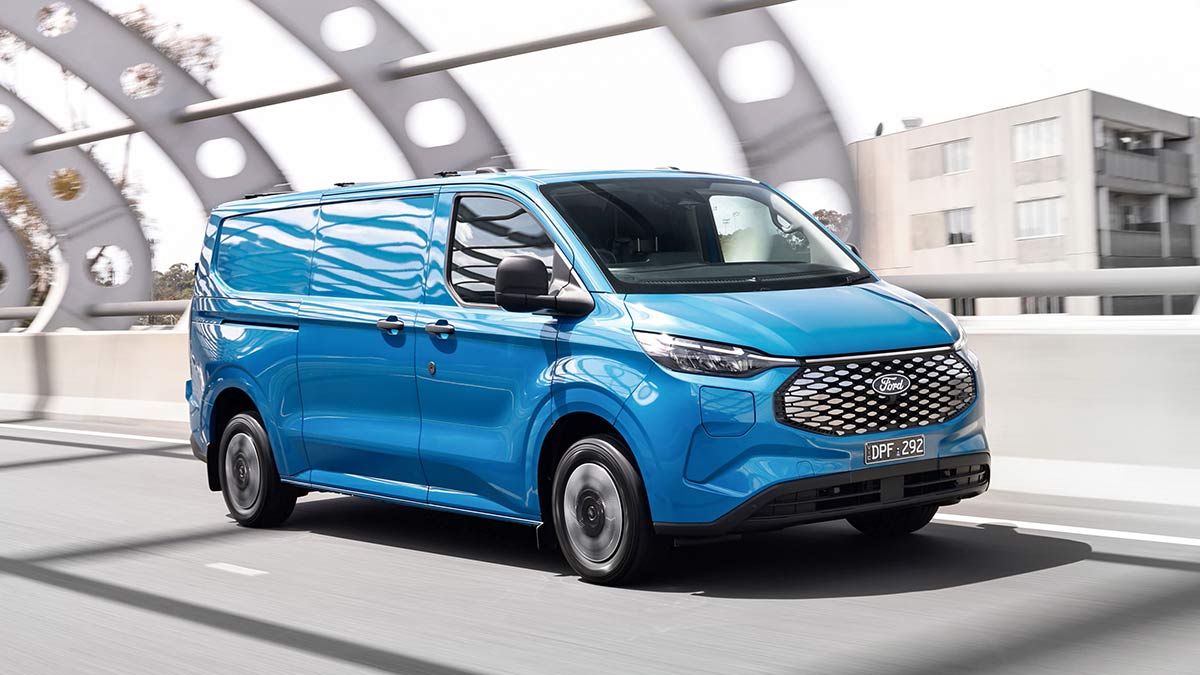
The Ford E-Transit Custom has a claimed driving range of 300km, making it best suited to city duties.
Is the Ford Transit Custom Trail, E-Transit and PHEV good to drive?
Some inner-city and suburban driving in the new 2025 Ford Transit Custom models – Trail, E-Transit and PHEV – gave us the chance to sample all three powertrains (diesel, EV and plug-in hybrid) back-to-back and to get a strong sense of their respective advantages and limitations, albeit without a load in the back.
All three were in their comfort zone, moving through traffic with relative ease, maintaining reasonable body control and soaking up Melbourne’s harsh road surfaces. That goes for both short- and long-wheelbase variants in EV and PHEV guise, although the unladen ride was less refined in the heaviest LWB E-Transit Custom (at almost 2.2t kerb weight).
There’s wind noise around the large wing mirrors at higher speeds, which is not uncommon for this class, and some tyre roar on coarser bitumen. But in general, the Transit Custom has a quiet cabin, thanks in large part to its standard-fit bulkhead isolating occupants from the cargo hold.
The electric-assist steering is light and the turning circle relatively tight at 10.9m in the SWB and 12.1m in LWB variants. A full surround-view camera would make life easier for the driver in all low-speed conditions, while the gear selector on the right-hand side of the steering column takes some getting used to – a left turn at a roundabout left us unblinkered and in neutral before realising our mistake.
The Ford E-Transit Custom provides strong and syrupy-smooth acceleration in the way that most EVs manage so well and can be driven on the throttle alone in stop-start traffic with its effective one-pedal mode. Its 64kWh NMC battery has a claimed 300km driving range (307km SWB Sport, 301km LWB Trend) on the WLTP standard, which is unremarkable and will be less in the real world but may be enough for city-based drivers. Ford Australia data puts Transit Custom drivers’ habitual daily distance at 78km, the longest daily distance at 307km and the vast majority (90th percentile) at 178km.
The carmaker quotes energy consumption of 24kWh/100km for the E-Transit (24.2 SWB/24.8 LWB), which we were well under in a heavy arterial and city traffic run from Broadmeadows to Albert Park (60km return). These were unladen vans, but for each 30km leg the trip computer showed 16kWh/100km (SWB) and 19kWh/100km (LWB).
The EV’s battery can be charged with DC power up to 125kW, taking 32 minutes for a 15-80% top-up at that rate, according to Ford. An AC charge from 0-100% using a home EV charger is quoted at 10.1 hours at 7.4kW, down to 6.7h with 11kW.
The Transit Custom PHEV is a much different van to drive, always ready to bring its combustion engine into the equation and impressing with its blend of strong performance and frugal fuel consumption. It relies on a small 11.8kWh NMC battery that restricts its EV-only range to a claimed 54km (WLTP), ruling out engine-free running for most drivers much of the time, which is disappointing.
The PHEV has three drive modes – Auto EV, EV Now and EV Later – for drivers to make the best use of the battery where possible, but rapid depletion sees Auto EV as the driving force. Despite this, fuel consumption isn’t prone to quickly blowing out in the petrol-electric hybrid. Another 60km round trip, this time from Broadmeadows to Yan Yean Reservoir near Doreen, returned 3.4L/100km in the LWB Trend on the first 30km run, half of that using the available battery charge in EV Now mode, while the pure hybrid return leg in the SWB Sport (Auto EV) showed 5.5L/100km.
Much longer testing is needed, but it’s a good indication that the PHEV will at least keep a lid on consumption with a depleted battery, which can’t be charged using DC power and needs 7h to be fully replenished with a 2.3kW/10A AC charge rate (4h15m at a max 3.5kW). In contrast, the AWD Trail has a claimed combined-cycle fuel economy figure of 8.5L/100km with its 2.0-litre turbo-diesel, which we were unable to test with only a short drive in mostly snarling traffic but shouldn’t be far off the real-world mark.
The diesel is less refined than the EV and PHEV variants and doesn’t feel as quick off the line, but it’s a muscular and responsive unit that gives us no cause for complaint in the unladen Custom Trail.
More: Does your van, ute, SUV or car match its fuel consumption claim?
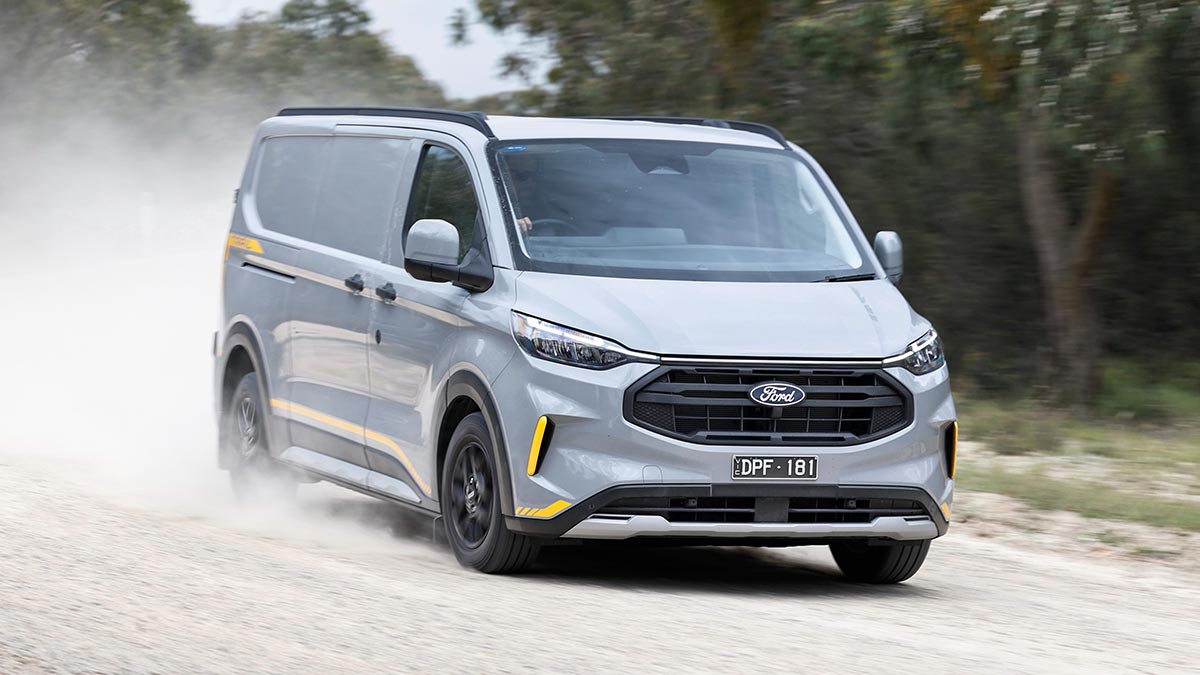
The 2025 Ford Transit Custom Trail has a specific driving mode to help with traction on gravel roads.
Is the Ford Transit Custom Trail good off-road?
The clear intent of the 2025 Ford Transit Custom Trail is to provide extra reassurance where traction is low. The permanent AWD system sends engine drive torque between the front and rear axle when wheel slip is detected – and even in advance of losing grip, according to Ford.
We didn’t get the chance to test the Transit Custom Trail in demanding conditions, but it’s designed to manage fire trails, dirt roads and unpaved access tracks, not tackle serious off-road excursions. The steel underbody protection is welcome, along with a selectable Trail driving mode that’s designed to optimise throttle calibration and the electronic stability control system for driving on loose surfaces.
That said, ground clearance on the Trail is identical to the regular diesel roadrunner, and there’s no low-range gearing, locking differentials and the like to take it further off the beaten track.
The vehicle we drove at launch also had all-purpose van/light-commercial tyres, but Ford says all-terrain rubber can be fitted standard.
Asked whether a harder-core off-road version was in the pipeline, Ford’s global LCV product development chief, Ian Foston, told RACV: “Never say never. We’re always listening to customers, saying, ‘Well, actually, what do you want?’ I think [standard] Trail is a good step into that domain. I don’t think we’ve done anything like that in Australia before, so let’s see how people react.”
What safety features does the Ford Transit Custom have?
All 2025 Ford Transit Custom variants have six airbags – driver, passenger (in the headlining rather than dash), side and head-protecting curtain airbags – and emergency call assist that’s designed to automatically notify emergency services in the event of a crash.
Advanced driver assistance systems (ADAS) include adaptive cruise control (with stop-and-go), autonomous emergency braking (with intersection assist), traffic sign recognition, various lane keeping aids, blind spot monitoring/assistance, rear cross traffic alert, forward collision warning, tyre pressure monitoring, trailer sway control and a safe exit warning. Front and rear parking sensors are also fitted standard, working with the rearview camera in tight areas.
There is no ANCAP safety rating for the Transit Custom, but in 2024 the ADAS system received a Platinum stamp in a comparative study with an excellent 96 per cent score (based on diesel variants). What’s more, as we’ve found with the Ford Ranger and Everest, the Transit Custom’s driver assist systems are well calibrated and effective.
How does the Ford Transit Custom compare?
The emphasis on work-life-play with the European-bred 2025 Ford Transit Custom Trail, and the alternatives to diesel brought with the E-Transit Custom and PHEV, are not common in the traditional mid-size van segment in Australia, so there are few competitors.
The new Volkswagen Transporter that’s now on sale has a 125kW/390Nm AWD option in both SWB and LWB diesel guise – priced from $62,590 and $64,590 plus on-road costs – as well as all-electric 210kW/415Nm BEV variants priced from a hefty $83,590 (SWB) and $85,590 (LWB). Plug-in hybrid variants arrive in the first half of 2026 with an EV driving range up to 60km, while the battery-electric Volkswagen ID. Buzz Cargo is also available from $79,990 plus on-roads.
Other alternatives include the Mecedes-Benz eVito (from $98,951), Peugeot e-Expert (from $79,990) or the more affordable LDV eDeliver 7 (from $67,358 plus ORCs, although current deals start at $64K drive-away for ABN holders). Also watch out for the all-new electric Kia PV5 coming in 2026.
Should I buy a Ford Transit Custom Trail, E-Transit or PHEV?
The 2025 Ford Transit Custom Trail is a welcome addition to the Blue Oval brand’s one-tonne van range, bringing AWD and a few rough-road-specific features into the equation to provide a fresh thought bubble for owners who would otherwise look to a ute like Ranger, or an SUV like Everest with a trailer.
The van has a bigger load space and better security on its side and impresses with its relatively easy-going nature. But this isn’t Europe and it’ll be a tough sell for prospective owners who’ll need to do their sums on the fit-out and, let’s face it, are sure to have a V6 Ranger dual-cab at similar money on their shortlist.
The E-Transit Custom and PHEV also present challenges in asking an extra 10 grand (for the plug-in hybrid) or 20 large (for the EV) compared to the competent diesel. The EV driving range on both is too short for our liking, but no compromise on load space keeps them in the game if the numbers stack up with savings brought with lower operating costs.
Between the two, the Transit Custom PHEV has the most appeal with its more versatile nature, the promise of low consumption and good potential over the long term with total cost of ownership, if it can be run as an EV in large doses.
For now, Ford has the PHEV mid-size van land all to itself, but tempting rivals are coming soon.
The information provided is general advice only. Before making any decisions please consider your own circumstances and the Product Disclosure Statement and Target Market Determinations. For copies, visit racv.com.au. As distributor, RACV Insurance Services Pty Ltd AFS Licence No. 230039 receives commission for each policy sold or renewed. Product(s) issued by Insurance Manufacturers of Australia Pty Ltd ABN 93 004 208 084 AFS Licence No. 227678.
